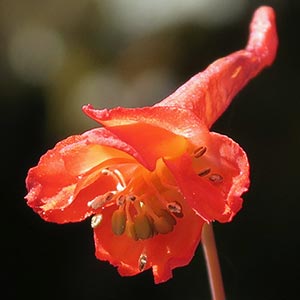Delphinium nudicaule
Delphinium glaucum
canyon delphinium, canyon larkspur, orange larkspur, red larkspur, red or orange larkspur, scarlet larkspur
Brown's larkspur, duncecap larkspur, giant, giant larkspur, glaucous larkspur, Hooker's larkspur, mountain, mountain larkspur, or tall larkspur, pale larkspur, pale-flower Brown's larkspur, Sierra larkspur, tall larkspur, western larkspur
(15-)20-50(-125) cm;
base reddish, glabrous.
(60-)100-200(-300) cm;
base usually green, glabrous, glaucous.
blade round to pentagonal, 2-6 × 3-10 cm; ultimate lobes 3-12, width 5-40 mm (basal), 2-20 mm (cauline).
blade round to pentagonal, 2-11 × 3-18 cm, margins seldom laciniate, glabrous; ultimate lobes 5-9(-15), width 5-24(-35) mm, tips abruptly tapered to mucronate apex;
midcauline leaf lobes more than 3 times longer than wide.
5-20(-69)-flowered;
pedicel (1.5-)2-6(-8) cm, glabrous to glandular-pubescent;
bracteoles 14-20(-30) mm from flowers, green to red, linear, 2-4(-9) mm, glabrous to puberulent.
(13-)40-90(-140)-flowered;
pedicel 1-3(-5) cm, puberulent or glabrous;
bracteoles 2-6(-10) mm from flowers, green to blue, linear, 2-7 mm, puberulent or glabrous.
sepals scarlet to reddish orange, rarely dull yellow, glabrous, lateral sepals forward-pointing to form pseudotube, (6-)8-13(-16) × 3-6 mm, spurs straight, slightly ascending, (12-)18-27(-34) mm;
lower petal blades elevated, exposing stamens, 2-3 mm, clefts 0.5-1 mm;
hairs sparse, evenly dispersed, yellow.
sepals bluish purple to lavender, puberulent, lateral sepals forward pointing to spreading, 8-14(-21) × 3-6 mm, spurs straight, ascending to ca. 45°, 10-15(-19) mm;
lower petal blades ± covering stamens, 4-6 mm, clefts 1-3 mm;
hairs centered, mostly near base of cleft, white.
13-26 mm, 3.5-4.5 times longer than wide, glabrous.
9-20 mm, 3.5-4.5 times longer than wide, glabrous to puberulent.
unwinged or sometimes slightly wing-margined;
seed coat cells with surfaces smooth.
wing-margined;
seed coat cells elongate but short, surfaces smooth or roughened.
= 16.
= 16.
Delphinium nudicaule
Delphinium glaucum
Delphinium nudicaule hybridizes with most other taxa of Delphinium that it encounters. Apparent hybrids involving D. nudicaule, and seen by the author (either afield or as specimens), include D. andersonii, D. antoninum, D. decorum, D. luteum, D. nuttallianum, D. patens, and D. trolliifolium. In addition, garden-grown plants have been hybridized with D. cardinale, D. elatum, D. menziesii, D. parishii, D. penardii, D. tatsienense Franchet, D. triste Fischer ex de Candolle, and D. uliginosum; D. nudicaule does not naturally occur with these species. Delphinium nudicaule is one of the earliest larkspurs to flower in any given locality. Douglas's type collection of D. nudicaule represents plants (synonyms D. sarcophyllum Hooker & Arnott and D. peltatum Hooker, an invalid name) grown under very moist conditions, probably quite near the ocean. The type specimen of D. armeniacum A. Heller represents plants grown under unusually dry conditions.
The Mendocino Indians consider Delphinium nudicaule a narcotic (D. E. Moerman 1986).
(Discussion copyrighted by Flora of North America; reprinted with permission.)
At the sites in Manitoba and Saskatchewan, Delphinium glaucum is naturalized, not native.
Delphinium glaucum hybridizes extensively with D. barbeyi in Utah and Colorado to the extent that hybrids [D. ×occidentale (S. Watson) S. Watson] are more common in many areas than individuals of either parental stock. It occasionally hybridizes with D. distichum, D. polycladon, D. ramosum, and D. stachydeum. Hybrids with D. brachycentrum are called D. ×nutans A. Nelson.
Tremendous variation is apparent in what is here recognized as Delphinium glaucum. This is the northern expression of the complex described in the discussion under Delphinium subsect. Exaltata. Although some geographic patterns are apparent in the variation within D. glaucum, infraspecific entities are not here recognized. Apparently because of rather recent and/or incomplete genetic isolation, the degree of differentiation between these units is not such that they can be consistently recognized.
Specimens named Delphinium splendens represent plants grown in high-moisture, low-light conditions and may occur as sporadic individuals anywhere from California to Alaska. Type specimens of D. brownii Rydberg, D. canmorense Rydberg, and D. hookeri A. Nelson represent plants grown on relatively dry sites at high latitudes. Plants from dry sites at low latitudes are represented by D. bakerianum Bornmüller and D. occidentale var. reticulatum A. Nelson. Plants with lavender to white flowers are represented by type specimens of D. brownii forma pallidiflorum B. Boivin and D. cucullatum A. Nelson. Type specimens of D. alatum A. Nelson and D. glaucum var. alpinum F. L. Wynd (an invalid name) represent plants growing above or near treeline.
Delphinium glaucum may be confused with D. californicum, D. exaltatum, D. polycladon, or D. stachydeum. For distinctions from D. californicum, see discussion under that species. Absence of basal or proximal cauline leaves, generally much larger plants (greater than 1.5 m), more flowers in the inflorescence, and shorter petioles on the leaves of D. glaucum are features that serve to distinguish this species from D. polycladon. In the latter, the leaves are primarily on the proximal stem, plants often less than 1.5 m, flowers more scattered, and petioles more than twice the length of leaf blades. Features of the sepals may be used to distinguish D. glaucum (dark lavender to blue purple, usually only minutely puberulent) from D. stachydeum (bright blue, densely puberulent). Vegetative parts of D. stachydeum are also densely puberulent, while those of D. glaucum typically are glabrous.
(Discussion copyrighted by Flora of North America; reprinted with permission.)
- Local floras:
BC,
CA,
OR,
WA
- Local Web sites:
CalFlora,
CalPhotos,
Flora NW,
PNW Herbaria,
Turner Photog.
WildflowerSearch
iNaturalist (observations)
USDA Plants Database
- LBJ Wildflower Center
- SEINet
- Plants of the World Online
- Encyclopedia of Life
- Wikipedia
- Google Image Search


